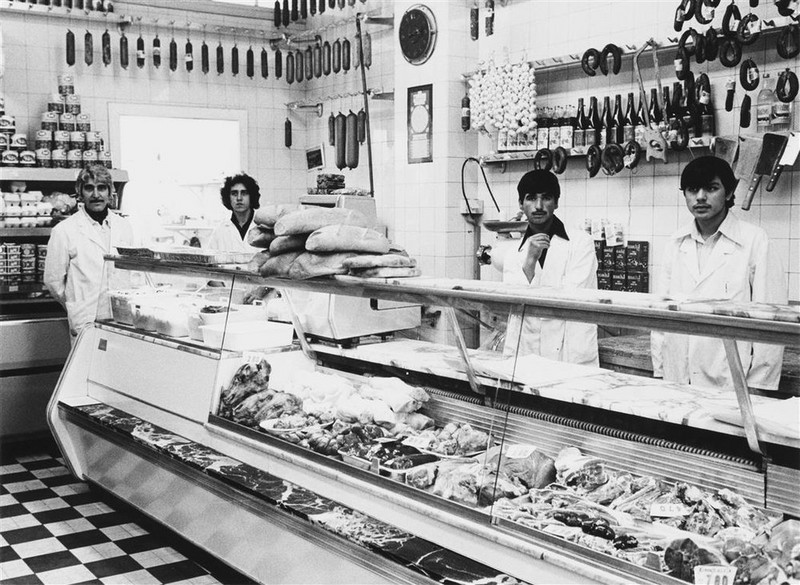Intractable and Untamed
28 Jun - 16 Nov 2014

Candida Höfer
Weidengasse Köln 1974
Aus: Türken in Deutschland, Silbergelatineabzug, Vintage, signiert, datiert, betitelt mit Annotationen
13,50 x 18,50 cm
Museum Ludwig
Weidengasse Köln 1974
Aus: Türken in Deutschland, Silbergelatineabzug, Vintage, signiert, datiert, betitelt mit Annotationen
13,50 x 18,50 cm
Museum Ludwig
INTRACTABLE AND UNTAMED
Documentary Photography around 1979
28 June - 16 November 2014
Curator: Barbara Engelbach
In times of sweeping societal transformations and crises, photography becomes an important medium. After all, as an image of reality, the photograph has an immediate impact that the photo theorist Roland Barthes, in his book Camera Lucida (1979), called untamed. It is this direct connection to reality, “The awakening of intractable reality,” that makes the documentary as well as the artistic approach significant in periods of radical change.
This applies, for instance, to the year 1979—the beginning of the so-called crisis decades, the consequences of which even today have an effect on economic and political conditions worldwide. Artists and photographers monitored and documented these global changes over longer periods of time, generally in the places where they lived. This activity often resulted in a multitude of photographs.
The exhibition therefore focuses not on individual images, but on series. It features one series for each of the thirteen artists and photographers represented in the museum’s collection, including Robert Adams, Joachim Brohm, Ute Klophaus, and Candida Höfer. Loans of works by David Goldblatt, Miyako Ishiuchi, and Raghubir Singh complement the collection.
Documentary standpoints are revealed not only by the photographs themselves, but also by the way in which they are used. The exhibition thus addresses five sets of issues in relation to each series of photographs: who the photographers were or are; when and where the photographs were taken; who commissioned them; where, how, and with which target audience in mind they were first published; and the extent to which they open up possibilities for photography today.
The title of the exhibition is derived from Roland Barthes' short book Camera Lucida, written in 1979 and first published in 1980, where he distinguished two responses to photography—its taming by means of aesthetic categories, including authorship, oeuvre, and genre, and its acceptance as an unflinching record of reality relying on untamed effects. Some twenty years later the exhibitions documenta 10 and 11, set up in 1997 and 2002 respectively, proved that viewing photography both as an art form and as a reproduction of reality need not be a contradiction in terms. On the contrary, Okwui Enwezor has shown that in its documentary capacity photography can redefine the relationship between aesthetics and ethics. Today, thirty-four years after the publication of Barthes’s volume, our exhibition examines documentary photographs dating from around 1979 in terms of their aesthetic, ethical, performative, and political engagement with reality.
Documentary Photography around 1979
28 June - 16 November 2014
Curator: Barbara Engelbach
In times of sweeping societal transformations and crises, photography becomes an important medium. After all, as an image of reality, the photograph has an immediate impact that the photo theorist Roland Barthes, in his book Camera Lucida (1979), called untamed. It is this direct connection to reality, “The awakening of intractable reality,” that makes the documentary as well as the artistic approach significant in periods of radical change.
This applies, for instance, to the year 1979—the beginning of the so-called crisis decades, the consequences of which even today have an effect on economic and political conditions worldwide. Artists and photographers monitored and documented these global changes over longer periods of time, generally in the places where they lived. This activity often resulted in a multitude of photographs.
The exhibition therefore focuses not on individual images, but on series. It features one series for each of the thirteen artists and photographers represented in the museum’s collection, including Robert Adams, Joachim Brohm, Ute Klophaus, and Candida Höfer. Loans of works by David Goldblatt, Miyako Ishiuchi, and Raghubir Singh complement the collection.
Documentary standpoints are revealed not only by the photographs themselves, but also by the way in which they are used. The exhibition thus addresses five sets of issues in relation to each series of photographs: who the photographers were or are; when and where the photographs were taken; who commissioned them; where, how, and with which target audience in mind they were first published; and the extent to which they open up possibilities for photography today.
The title of the exhibition is derived from Roland Barthes' short book Camera Lucida, written in 1979 and first published in 1980, where he distinguished two responses to photography—its taming by means of aesthetic categories, including authorship, oeuvre, and genre, and its acceptance as an unflinching record of reality relying on untamed effects. Some twenty years later the exhibitions documenta 10 and 11, set up in 1997 and 2002 respectively, proved that viewing photography both as an art form and as a reproduction of reality need not be a contradiction in terms. On the contrary, Okwui Enwezor has shown that in its documentary capacity photography can redefine the relationship between aesthetics and ethics. Today, thirty-four years after the publication of Barthes’s volume, our exhibition examines documentary photographs dating from around 1979 in terms of their aesthetic, ethical, performative, and political engagement with reality.
